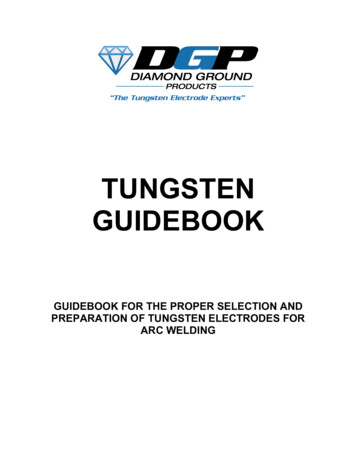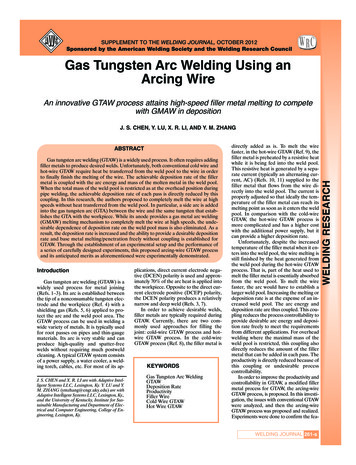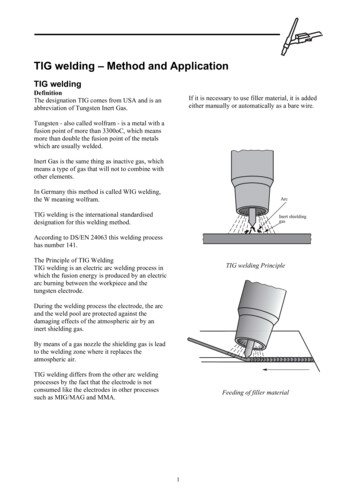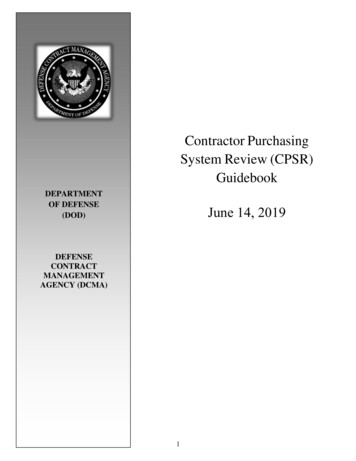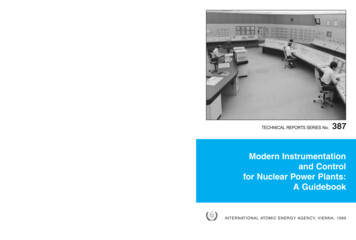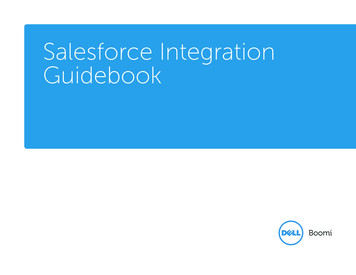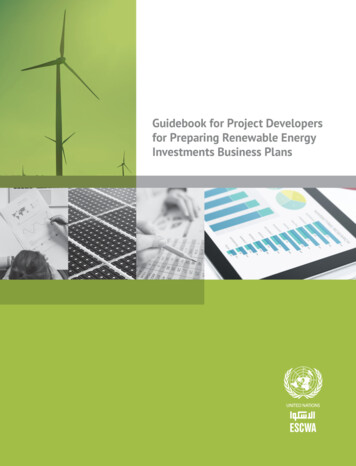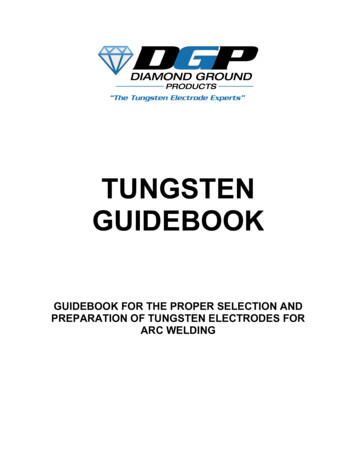
Transcription
TUNGSTENGUIDEBOOKGUIDEBOOK FOR THE PROPER SELECTION ANDPREPARATION OF TUNGSTEN ELECTRODES FORARC WELDING
Nineth Printing: June 2013This Guidebook for the Proper Selection and Preparation of Tungsten Electrodes for ArcWelding is an effort to provide information for use by welders in various industries.Reasonable care was taken in the compilation and publication of this guidebook toensure the authenticity of its contents. No representation or warranty is made as to theaccuracy or reliability of this information, or to imply fitness for any purpose. Theinformation in this document is subject to change without notice.The information contained in this guidebook may not be construed as a grant of anyright of manufacture, sale, use or reproduction in connection with any method, process,product, or system which is covered by patent, copyright, or trademark. No effort hasbeen made to determine whether any information in this booklet is covered by patent,copyright, or trademark and no research has been conducted to determine whether aninfringement would occur.This booklet, in part or entirety, may not be reproduced without the express writtenpermission of Diamond Ground Products, Inc.DIAMOND GROUND PRODUCTS“The Tungsten Electrode Experts”2651 Lavery Court Newbury Park, CA 91320 Tel: 805-498-3837 Fax: 805-498-9347 www.diamondground.comTungsten GuidebookRevision: 8.0 (June 2013)Page 2 of 27
Table of Contents1Introduction . 42Choosing the Proper Tungsten . 62.1The Basics . 62.2Determinants of Tungsten Performance . 82.2.1Manufacturing Variables . 82.2.2Physical Characteristics of Different Oxides . 92.3Oxide Types . 112.3.1Thoriated (EWTh-1 Yellow Stripe Electrode Classifications:Yellow Stripe; and EWTh-2 Electrode Classifications: RedStripe) . 112.3.2Ceriated (EWCe-2 Electrode Classification: Grey/ FormerlyOrange Stripe) . 122.3.3Lanthanated (EWLa Electrode Classification) . 132.3.4Zirconiated Tungsten (EWZr01 Electrode Classification: BrownStripe; and EWZr-8 Classification: White Stripe) . 132.3.5Pure Tungsten (EWP Electrode Classification: Green Stripe) 132.3.6Other Options . 142.3.7Electrode Sizes and Current Capacities . 142.4Determining Which Tungsten to Use . 153Proper Preparation . 163.1Electrode Geometry. 163.2The Proper Equipment . 203.3Proper Grinding and Cutting Techniques . 213.4Safety Suggestions . 254DGP Products that Meet Welders’ Needs . 274.1The Proper Tungsten. 274.2The Proper Precision Tungsten Electrode Grinders . 274.3Properly Pre-Ground and Cut Electrodes . 274.4Replacement Tungsten Grinder Wheels. 27DIAMOND GROUND PRODUCTS“The Tungsten Electrode Experts”2651 Lavery Court Newbury Park, CA 91320 Tel: 805-498-3837 Fax: 805-498-9347 www.diamondground.comTungsten GuidebookRevision: 8.0 (June 2013)Page 3 of 27
1IntroductionThis specification is intended to assist welders in selecting and preparing one of themost important and frequently overlooked welding process variables: the electrode.Welders can spend thousands of dollars on welding equipment, but if they do not selectand prepare their electrodes with this less expensive process component properly, thentheir welding results can be poor, inconsistent, or problematic. This guide will helpeliminate this variable as a concern in your welding and make it an asset.This information applies only to the selection and preparation of electrodes for GasTungsten Arc Welding (GTAW), also known as Tungsten Inert Gas (TIG) welding andPlasma Arc Welding (PAW). The different types of GTAW and PAW welding that thisapplies to includes but is not limited to Orbital Tube and Pipe Welding,Automatic/Mechanized TIG Welding, “Micro-TIG,” Automatic/Mechanized PlasmaWelding, “Micro-Plasma,” and Manual Arc Welding. The section of this booklet thatdescribes the proper electrode grinding techniques is dedicated almost entirely to directcurrent welding, since electrodes for alternating current welding are usually balled andnot ground.GTAW is used in many industries, including Aerospace, Semiconductor,Biotechnology/Pharmaceutical, Tube Producers, Contractors, Automotive, Fitting andValve Manufacturers, Industrial, Nuclear, and Specialty Gases.Table 1: Applications for Correctly Ground, Cut and Prepared Tungsten WeldingElectrodes For TIG Welding ApplicationsOrbital TIG/ Tube To produce the high quality orbital fusion welds required of today'sWeldinghigh tech industries, tungsten electrode shape is an importantvariable that must be kept consistent. Most orbital manufacturersrequire a precise tungsten length.Orbital TIG/ PipeWeldingOrbital pipe welding application using TIG is primarily limited to thenuclear, pharmaceutical, and chemical processing industries. Theseindustries, along with a few not mentioned, require X-ray perfectorbital pipe welds in the 125 amp - 300 amp current range.A consistently prepared electrode is required for consistent currentflow and arc voltage characteristics. Most orbital pipe welders use3/32 or 1/8 diameter electrodes. They also must be cut-to-length,however, not as precise as the orbital tube welder.DIAMOND GROUND PRODUCTS“The Tungsten Electrode Experts”2651 Lavery Court Newbury Park, CA 91320 Tel: 805-498-3837 Fax: 805-498-9347 www.diamondground.comTungsten GuidebookRevision: 8.0 (June 2013)Page 4 of 27
Mechanized TIGWeldingMechanized Tig Welding encompasses a wide spectrum ofapplications such as precision bellows welding using .040 diametertungsten electrode at 1.0 ampere up to high speed tube millswelding with a .250 diameter tungsten electrode using current ashigh as 600 amperes. A precise yet consistent electrode will have adramatic effect in weld results and tungsten electrode life. Cuttingthe tungsten electrode is usually required if the electrode is grosslycontaminated.Manual TIGWeldingArc starting and arc stability from a consistently prepared tungstenelectrode will be beneficial to the manual welder. Most hand welding'FIG torches require a 7.0" long electrode be cut in half to fit themanual welding torch. This can be accomplished best with thediamond cutting mechanism described in this booklet.Manual &MechanizedPlasma ArcWeldingThe plasma arc welding process requires a very precisely shaped,tungsten electrode. The tip of the tungsten must be kept concentricto the diameter to place it in the correct position centered in theplasma torch. This is a critical parameter adjustment in plasma arcwelding. Most plasma welding torches also require a cut-to-lengthtungsten electrode.The technical details of TIG and PLASMA arc welding are that an electric arc istransferred from a tungsten electrode to a work piece. Typically, to initiate the arc, highvoltage is used to break down and ionize the shielding gas between the electrode andthe work piece. Current is then transferred from the electrode to the work to create anelectric arc. The tungsten electrode serves as the terminal for the electric arc and fusestogether either with or without filler material. Although there are different methods of arcinitiation, high voltage arc starting is the standard used in this guidebook.There are several variables to consider in a welding procedure. Tungsten electrodegeometry affects the arc shape (thereby affecting the weld bead size and shape), theweld penetration, and point longevity of the electrode. Proper electrode grindingprocedures and equipment should be used in order to ensure that electrodes aredimensionally correct. Finally, different tungsten materials posses differentcharacteristics in arc start ability, electrode life, and contamination resistance. Thismakes the selection of the proper material for your application an important variable inwelding performance. The proper preparation of electrodes in each of these areas willprovide the benefits of consistent welding with optimum performance.DIAMOND GROUND PRODUCTS“The Tungsten Electrode Experts”2651 Lavery Court Newbury Park, CA 91320 Tel: 805-498-3837 Fax: 805-498-9347 www.diamondground.comTungsten GuidebookRevision: 8.0 (June 2013)Page 5 of 27
2Choosing the Proper TungstenThe proper tungsten material to use for an application depends on many variables,including the type of weld, the composition of the material being welded, the amperagelevel, among other factors. The following section discusses available options andhighlights the accepted standards. The recommendations provided are based oninformation from industry end users and tungsten manufacturers. However, because ofthe many variables present in the welding process, it is difficult to generalize. The bestway to determine which tungsten material is best suited for a particular application isthrough testing.2.1The BasicsDiameters and Lengths: Tungsten Electrodes are available in a variety of standarddiameters and lengths. The most commonly used diameters are shown in Table 2.Table 2: Common Tungsten Electrodes (U.S. and Metric Measurements)U.S. Customary MeasurementsMetric Measurements.040”1.0 mm1/16” (.062” and .060”)1.6 mm3/32” (.093”)2.4 mm1/8” (.125”)3.2 mm5/32” (.156”)4.0 mm3/16” (.187”)4.8 mmIn addition to these sizes, some manufacturers also offer .020” (0.5mm) and ¼” (6.4mm) tungsten. The most common length is 7.00” (175 mm). Tungsten is normally soldin boxes of 10 pieces.DIAMOND GROUND PRODUCTS“The Tungsten Electrode Experts”2651 Lavery Court Newbury Park, CA 91320 Tel: 805-498-3837 Fax: 805-498-9347 www.diamondground.comTungsten GuidebookRevision: 8.0 (June 2013)Page 6 of 27
Current Ranges: Refer to Table A.2 of AWS A5.12M/A5.12:2009 Specification forTungsten and Oxide Dispersed Tungsten Electrodes for Arc Welding and Cutting. TheAmerican Welding Society document provides a table that shows the general currentranges for tungsten using Direct Current (DC) and Alternating Current (AC). All valueslisted are based on using argon as the shielding gas. Different electrode materials willvary slightly from these guidelines. Use of other gases will also change therecommended currents. As such, this chart should be used as a general guide. Alsokeep in mind that for a given amount of amperage, larger diameter electrodes will lastlonger, but will be harder to arc start. Excessive current will cause the electrode to meltand drop off. Insufficient current will lead to unstable arc.International Color Coding Chart: Each stick of tungsten has a color code applied toone end which identifies the material type of the tungsten. Refer to Table 1 of AWSA5.12M/A5.12:2009 Specification for Tungsten and Oxide Dispersed TungstenElectrodes for Arc Welding and Cutting. The American Welding Society documentprovides a table that identifies the color coding used in United States, Europe, andJapan, which represent the bulk of the market share of sold tungsten.Standards: The United States, Europe, and Japan each have a published standard fortungsten as shown in Table 3. These standards dictate the dimensions, packaging, andmanufacturing requirements that tungsten must meet. However, meeting thesestandards does not guarantee that a particular tungsten was manufactured by a highquality manufacturer.Table 3: Tungsten StandardsMarket AreaStandard NameUnited StatesANSI/AWS A5.12CanadaASME/SFAEuropeISO 6848JapanJISDIAMOND GROUND PRODUCTS“The Tungsten Electrode Experts”2651 Lavery Court Newbury Park, CA 91320 Tel: 805-498-3837 Fax: 805-498-9347 www.diamondground.comTungsten GuidebookRevision: 8.0 (June 2013)Page 7 of 27
2.2Determinants of Tungsten PerformanceIn most applications, welders use tungsten that contains an emission-enhancing oxidesuch as Thorium, Cerium, or Lanthanum. These oxides naturally migrate from inside thetungsten to the heat at the point of the electrode, where they give off their oxide elementin the arc, and leave a film of the metal alloy on the tip. This causes the electrode tohave a different temperature at the tip based on the work function of that element. Theoxides that are emitted at the tip serve to improve arc starting and stability. They alsocause the electrode to provide the same level emission as pure tungsten at much lowertemperatures. Lower temperatures improve the longevity of the tungsten and keep thegrains within the tungsten smaller for improved arc stability. Thus, oxides are a veryimportant part of tungsten. Each oxide has unique physical characteristics that affecttungsten performance. In addition, the technique used in manufacturing the tungstenwill also affect its performance.2.2.1 Manufacturing VariablesGrain Size and Structure: Figure 1 shows the molecular structure of the inside of apoint of tungsten and how it is divided into smaller groups called grains. Oxides migrateto the tip of the tungsten primarily along the boundaries or borders or these grains. It ismuch easier for the oxides to migrate from inside the tungsten to the tip on the grainboundaries than it is for them to migrate within the crystallized grains. In manufacturingthe tungsten, smaller sized grains are better, because they produce more paths andtherefore the oxides can more easily migrate to the tip. However, it is a difficultmanufacturing process to minimize the size of the grains while maximizing theconsistency of the oxide distribution and maintaining the proper quantity of oxides. Thisdifficulty in the manufacturing process is the primary reason for the differences intungsten performance quality that is produced by the different manufacturers.Figure 1: Molecular Structure of the Inside Point of TungstenDIAMOND GROUND PRODUCTS“The Tungsten Electrode Experts”2651 Lavery Court Newbury Park, CA 91320 Tel: 805-498-3837 Fax: 805-498-9347 www.diamondground.comTungsten GuidebookRevision: 8.0 (June 2013)Page 8 of 27
During the extreme temperatures of welding, the grains have a tendency to combinewith larger neighboring grains to form one large grain in a process called “grain growth.”However, if a continuous flow of oxides at the grain boundaries is maintained, thisserves to surround the grains and keep them from combining. Thus, oxides are graingrowth inhibitors. When tungsten runs out of oxides in any area, the grains combinereadily, and the tungsten performs poorly because the oxides lack avenues to move tothe surface. In Figure 1 the 2% Lanthanated electrode still has a very small grainstructure even after one hour of welding time at 180 amps on a 1/16” electrode. Thiscondition is the result of quality manufacturing and the oxide properties of 2%Lanthanated tungsten.Oxide Distribution and Size: Oxide distribution is a key indicator of quality. Oxidesshould be distributed homogenously throughout the tungsten. Uneven distributionresults in poor performance: areas with little or no oxides will tend to suffer from graingrowth, whereas areas with too much oxide will tend to “bottleneck” and prevent theoxides from getting to the point. Higher quality oxides are smaller in size, which allowsthem to migrate to the tip easier.2.2.2 Physical Characteristics of Different OxidesElectron Work Function (eV): Work function is the energy needed to remove anelectron from an atom, and it is measured in electron volts (eV). The lower the workfunction of an electrode, the lower the voltage necessary to strike an arc, thus the easierthe arc starts. The oxides added to a tungsten serve to promote the electron emissionby lowering the work function of the tungsten. Table 4 lists different oxides and metalsand their respective work functions. The lower the eV for the oxide, the easier it willstart. The metal work function is important, because upon emitting an oxide, the metal isleft as a film on the tip. The lower the eV of the metal at the tip, the lower thetemperature will be at the tip which will decrease grain growth and provide a constantflow of oxides and longer service life.Table 4: Physical Properties of OxidesMaterialOxide eVMetal eVLanthanum2.53.3Thorium2.63.35Cerium3.22.84Pure TungstenNo oxide present4.5DIAMOND GROUND PRODUCTS“The Tungsten Electrode Experts”2651 Lavery Court Newbury Park, CA 91320 Tel: 805-498-3837 Fax: 805-498-9347 www.diamondground.comTungsten GuidebookRevision: 8.0 (June 2013)Page 9 of 27
The more of an oxide added to tungsten, the lower the work function that tungsten willhave, and thus the better it will arc start. A 2% Lanthanated tungsten will arc start moreeasily than a 1% Lanthanated tungsten (assuming they were made using the samemanufacturing process).Note: It is difficult to compare different types of electrodes without testing because ofthe different properties of the oxides.Density: Each oxide has a different density. Thus a 2% by weight thorium, cerium, orlanthanum electrode will all have different amounts of oxides by volume. Table 5describes the difference between density and weight for different materials.Table 5: Density versus Weight of an Oxide in a MaterialMaterialDensity (g/cm3)Volume % of 2% byweight 5.2Although each material has 2% by weight of the oxides, a 2% Lanthanated tungsten hasa significantly higher volume of oxides than 2% Thoriated tungsten to feed to the tip.Note: Even if electrodes are the same type, electrodes of different manufacturerscannot be compared using only the work function and volume of oxides, becausethis comparison would not take into account the important manufacturingvariables such as grain size and structure of the oxide size and distribution.Therefore, the work function and oxide density numbers should only be used asa general guide. Testing is always the best way to determine which tungsten willbe best for you.DIAMOND GROUND PRODUCTS“The Tungsten Electrode Experts”2651 Lavery Court Newbury Park, CA 91320 Tel: 805-498-3837 Fax: 805-498-9347 www.diamondground.comTungsten GuidebookRevision: 8.0 (June 2013)Page 10 of 27
Migration and Evaporation Rates: The migration rate, or diffusion rate as it is oftencalled, is the rate at which each of the different oxides naturally travels from inside thetungsten to the heat at the tip of the electrode. The evaporation rate is the rate at whichthe oxides separate from their metal component and are emitted at the tip of theelectrode. The optimum-performing electrode is one that has a balance of goodmigration and evaporation rates. If the migration rate is slower than the evaporationrate, then there will be an inadequate amount of oxides arriving at the tip to maintain aconsistent arc and the tungsten may be reduced to the performance level of puretungsten. If the evaporation rate is slower than the migration rate, the oxides will becrowded at the point. If both of the rates are very high, welding properties at thebeginning of welding will be great, but all of the oxides may be used up quickly.2.3Oxide TypesThe following provides a description of the general characteristics of common oxidetypes. Keep in mind that testing is the only way to determine which tungsten is optimalfor a particular application.2.3.1 Thoriated (EWTh-1 Yellow Stripe Electrode Classifications: Yellow Stripe;and EWTh-2 Electrode Classifications: Red Stripe)Thoriated tungsten contains thorium oxide (THO2 or thoria), and it is the mostcommonly used tungsten in America. It has become the standard for comparison.However, because it is a low-level radioactive hazard, many users have switched toother alternatives. 2% Thoriated tungsten is a good general use tungsten. It has one ofthe lowest work functions, and it performs well when overloaded with extra amperage.However, it does not hold its point as well as some other non-radioactive tungstens thathave been introduced.Two types of Thoriated tungsten electrodes are available. The EWTh-1 and EWTh-2electrodes contain 1 percent and 2 percent, respectively, evenly dispersed through theirentire lengths. Thoriated tungsten electrodes are superior to pure tungsten electrodes inseveral respects. The thoria provides about 20 percent higher current-carrying capacity,generally longer life, and greater resistance to contamination of the weld. With theseelectrodes, arc starting is easier, and the arc is more stable than with pure tungsten orZirconiated tungsten electrodes. The EWTh-1 and EWTh-2 electrodes were designedfor DCEN applications. They maintain a sharpened tip configuration during welding,which is desirable for welding steel. They are not often used with AC because it isdifficult to maintain the balled end, which is necessary with AC welding, without splittingthe electrode.DIAMOND GROUND PRODUCTS“The Tungsten Electrode Experts”2651 Lavery Court Newbury Park, CA 91320 Tel: 805-498-3837 Fax: 805-498-9347 www.diamondground.comTungsten GuidebookRevision: 8.0 (June 2013)Page 11 of 27
2.3.2 Ceriated (EWCe-2 Electrode Classification: Grey/ Formerly Orange Stripe)Ceriated tungsten was introduced into the United States in the early 1980s as the firstnon-radioactive alternative to Thoriated tungsten. It is most commonly offered as 2%Ceriated tungsten, and it is readily available. The EWCe-2 electrodes are tungstenelectrodes containing 2 percent cerium oxide (CEO2), referred to as ceria. It is known tobe especially good for DC welding with low amperage because it starts very easily atlow amps and usually requires about 10% less amps than Thoriated material to operate.Thus it is the most popular material used for orbital tube and pipe welding, and it is alsocommonly used for welding very small parts. Compared with pure tungsten, theCeriated electrodes exhibit a reduced rate of vaporization or burn-off. Theseadvantages of ceria improve with increased ceria content. Cerium also has the highestmigration rate so it gives it good welding properties at the beginning, but it has asignificantly reduced migration rate over time due to grain growth. However, at loweramperages it should last longer than Thoriated tungsten. Because of these properties, itis generally good for short welding cycles or when a specific number of welds are calledfor and then the electrode is to be replaced. Higher amperage applications are best leftto Thoriated or Lanthanated material. EWCe-2 electrodes will operate successfully withAC or DC, however, it is used primarily for DC welding as it may split if used for ACwelding.DIAMOND GROUND PRODUCTS“The Tungsten Electrode Experts”2651 Lavery Court Newbury Park, CA 91320 Tel: 805-498-3837 Fax: 805-498-9347 www.diamondground.comTungsten GuidebookRevision: 8.0 (June 2013)Page 12 of 27
2.3.3 Lanthanated (EWLa Electrode Classification)The most common Lanthanated tungsten contains 2 percent lanthanum oxide (La203),referred to as lanthana. In Europe and Japan, Lanthanated tungsten has been the mostpopular alternative to 2% Thoriated tungsten for most applications. It is available as 2%,1.5%, and 1% Lanthanated tungsten. Lanthanum Trioxide has the lowest work functionof any if the materials thus it usually starts easiest and has the lowest temperature atthe tip, which resists grain growth and promotes longer service life. Testing of 2%Lanthanated material has shown that it offers a much longer life than Thoriated if notoverloaded and better arc starting in most applications. It is also especially good at (a)resisting the “Thermal shock” of pulsing, (b) working in welding in situations where thereare numerous re-ignitions with a short weld cycle, and (c) resisting contamination.Welders with tube mill applications have been especially satisfied with this materialbecause its longer life reduces down time. Also, as a general rule it will probably requireabout 15% less amps to start and sustain low current arcs. The Lanthanum in thistungsten is a “rare earth” material and is not radioactive. It has not been as heavilymarketed and used in the United States as in Europe or Japan, however DiamondGround Products, Inc. has been offering this material since 1993. This tungsten isprimarily used for DC welding, but will also show good results for AC welding. TheEWLa-1 electrodes were developed around the same time as the Ceriated electrodesand for the same reason, that lanthanum is not radioactive. These electrodes contain 2percent lanthanum oxide (La203).2.3.4 Zirconiated Tungsten (EWZr01 Electrode Classification: Brown Stripe; andEWZr-8 Classification: White Stripe)Zirconiated tungsten electrodes (EWZr) contain a small amount of zirconium oxide(ZrO2). Zirconiated tungsten electrodes have welding characteristics that generally fallbetween those of pure and Thoriated tungsten. Zirconiated tungsten is most commonlyused for AC welding because it balls up well in AC welding and has a more stable arcthan pure tungsten. It also resists contamination well in AC welding. However, while ithas better current carrying and arc starting characteristics than pure tungsten, on thewhole it is the worst non-radioactive tungsten from a performance standpoint.2.3.5 Pure Tungsten (EWP Electrode Classification: Green Stripe)Pure tungsten electrodes (EWP) contain a minimum of 99.5 percent tungsten, with nointentional alloying elements. Pure tungsten has a very high work function, and thus it ismore difficult to start and produce a stable arc than other materials. Also, because ofthe high work function, the temperature at the tip is higher and grain growth occurs. Thisleads to an unstable arc, starting difficulty, and a shorter service life. Pure tungsten isonly used for AC welding; however; better alternatives are available.DIAMOND GROUND PRODUCTS“The Tungsten Electrode Experts”2651 Lavery Court Newbury Park, CA 91320 Tel: 805-498-3837 Fax: 805-498-9347 www.diamondground.comTungsten GuidebookRevision: 8.0 (June 2013)Page 13 of 27
2.3.6 Other OptionsIn addition to the materials listed above, there are other less common materials, such as1% Thoriated, 4% Thoriated, 2% Yttriated, and also mixes of different oxides in thesame tungsten. Diamond Ground Products, Inc. introduced tungsten called TRI MIXTM,which combines three non-radioactive materials into one tungsten. The goal was tomake the best possible tungsten by balancing the migration and evaporation rates,while keeping the work function down. It starts and re-ignites very well, and it offers aparticularly excellent service life in welding situations where welding cycles of at least15 minutes are used. Technical studies in Japan have shown that mixed tungsten isvery successful in optimizing welding, and thus it is expected that more of this type ofproduct will become available in the U.S. market. The Japanese and European marketsare already recognizing the benefits of combining three non-radioactive oxides into oneelectrode. Cryo-T tungsten is a Thoriated tungsten that has been treated with a multistep cryogenic process. This process produces a more dense structure of the Thoriatedtungsten blend. User testing has shown that Cryo-T tungsten has resulted in: Easier starting compared to 2% Thoriated tungsten. A much longer tip life compared to non-treated 2% Thoriated tungsten electrodes. More consistent welds as a result of crisp starts. Longer overall electrode life when compared to a 2% Thoriated tungsten. Higher amperage tolerance as compared to a 2% Thoriated tungsten.Cryo-T is recommended for all current users of 2% Thoriated tungsten.2.3.7 Electrode Sizes and Current CapacitiesSelecting the correct electrode for specific applications must take into account thedifferent current levels and power supplies. Current levels that are in excess of thoserecommended for a given electrode size and tip configuration will cause the tungsten toerode or melt. Tungsten particles may fall into the weld pool and become defects in theweld joint. Current levels that are too low for a specific electrode diameter can cause arcinstability. Direct current with the electrode positive requires a much larger diameter tosupport a given level of current, because the tip is not cooled by the evaporation ofelectrons but heated by their impact. In general, a given electrode diameter on DCEPwould be expected to handle only 10 percent of the current possible with the electrodenegative. With alternating current, the tip is cooled during the electrode negative cycleand heated when positive. Therefore, the current carrying capacity of an electrode onAC is between that of DCEN and DCEP. In general, it is about 50 percent less than thatof DCEN.DIAMOND GROUND PRODUCTS“The Tungsten Electrode Experts”2651 Lavery Court Newbury Park, CA 91320 Tel: 805-498-3837 Fax: 805-498-9347 www.diamondground.comTungsten GuidebookR
tungsten electrode at 1.0 ampere up to high speed tube mills welding with a .250 diameter tungsten electrode using current as high as 600 amperes. A precise yet consistent electrode will have a dramatic effect in weld results and tungsten electrode life. Cutting the tungsten electrode is u
